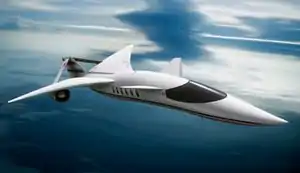SAI Quiet Supersonic Transport
The SAI Quiet Supersonic Transport (QSST) was/is a project by Supersonic Aerospace International (SAI) to develop a "virtually boomless" commercial supersonic business jet. The project was announced around the year 2000 and provided update announcements until 2010. After three years without any updates, the last update was in 2013.
| QSST | |
|---|---|
 | |
| Artist's impression of the QSST | |
| Role | Supersonic business jet |
| Manufacturer | Supersonic Aerospace International |
| Design group | Lockheed Martin Skunk Works[1][2] |
| Status | Unknown |
Design and development
The Lockheed Martin Skunk Works began developing the QSST in May 2001 under a $25-million contract from SAI. Designed to cruise at an altitude of 60,000 feet at speeds of Mach 1.6 to 1.8 (approximately 1,218 to 1,370 statute miles per hour) with a range of 4,600 statute miles, the two-engine gull-wing aircraft was designed to create a sonic boom only 1% as strong as that generated by the Concorde.[3]
SAI invited engine proposals from General Electric, Pratt & Whitney and Rolls-Royce. Each of the QSST's two engines must generate 33,000 pounds of thrust, comparable to the power of engines for midsize airliners. The price per aircraft was expected to be about $80 million.[3] SAI had planned to select an engine once an international consortium to manufacture the jet was completed, achieve first flight in 2017, and begin customer deliveries by 2018.
The reduction in sonic-boom energy is achieved by increasing the ratio of length to wingspan, using canards, and ensuring that the individual pressure waves generated by each part of the aircraft structure reinforce each other less significantly, producing a light rumble on the ground without an objectionable sonic boom like conventional supersonic aircraft.
Supersonic Aerospace International
Supersonic Aerospace International, LLC (SAI) was an American aerospace firm. The company was begun in 2001 by Michael Paulson, son of Gulfstream Aerospace founder Allen Paulson. It was working to build the QSST though there has been no news of the project since the company's website went dormant in 2010.
See also
Aircraft of comparable role, configuration, and era
- Tu-444
- Aerion AS2
- Sukhoi-Gulfstream S-21
Related lists
- List of airliners
References
- "Quiet Supersonic Technology X-Plane".
- "NASA Wind Tunnel Tests Lockheed Martin's X-Plane Design for a Quieter Supersonic Jet" (Press release). NASA.
- Eric Hagerman (March 1, 2007). "All sonic, no boom". Popular Science.
External links
- Official website
- Popular Science: All Sonic, No Boom", by Eric Hagerman Posted 03.01.2007